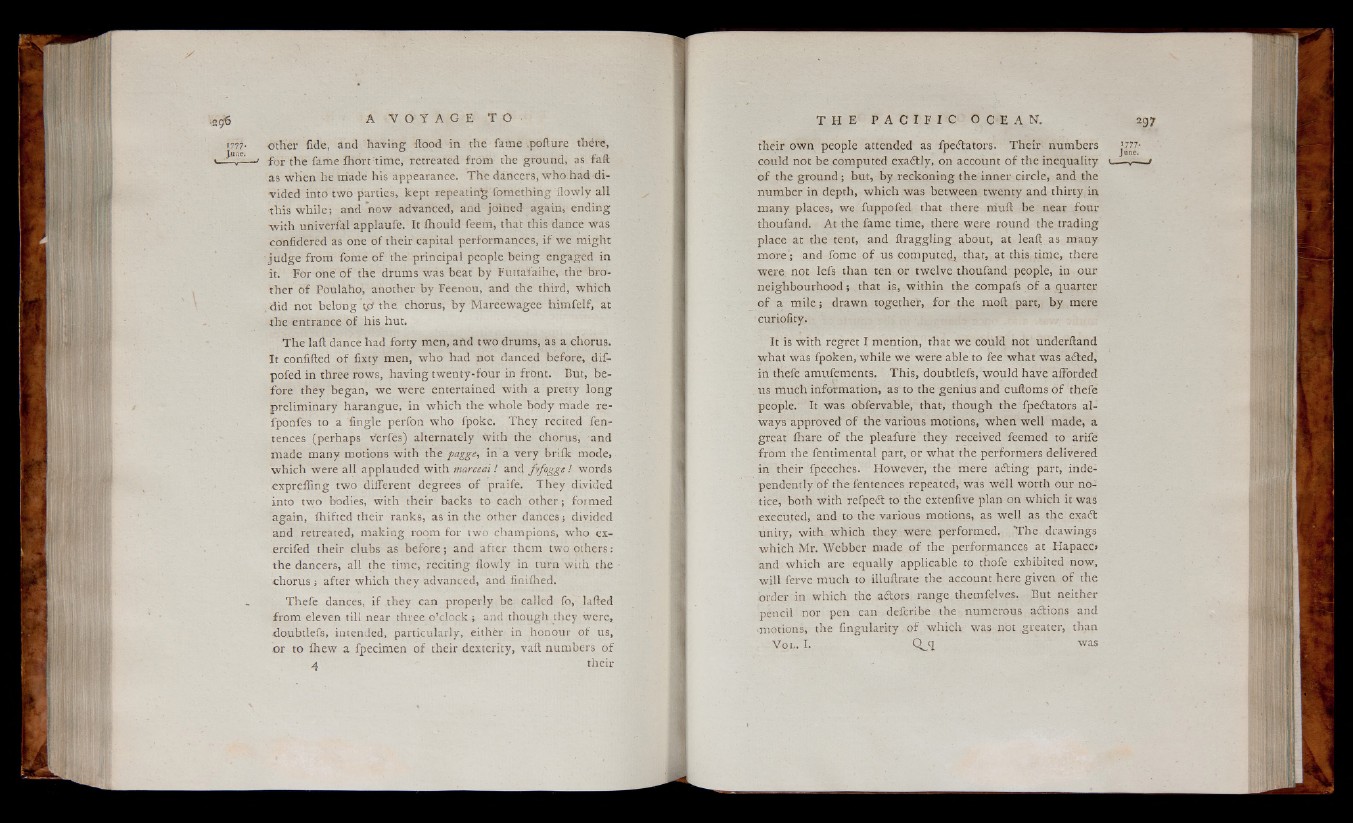
1777•
J«ne. other fide, and having flood in the fame .pofture there,
for the fame ihort time, retreated from the ground, as faft as when he made his appearance. The dancers, who had divided
into two parties, kept repeating fomething (lowly all
this while; and now advanced, and joined again, ending with universal applaufe. It ihould feem, that this dance was
confidered as one of their capital performances, if we might
judge from fome of the principal people being engaged in it. For one of the drums was beat by Futtafaihe, the brother
of Poulaho, another by Feenou, and the third, which
did not belong to' the. chorus, by Mareewagee himfelf, at
the entrance of his hut.
The laft dance had forty men, and two drums, as a chorus. Ft confifted of fixty men, who had not danced before, dif- pofed in three rows, having twenty-four in front. But, before
they began, we were entertained with a pretty long preliminary harangue, in which the whole body made re- fponfes to a fingle perfon who fpoke. They recited fen-
tences (perhaps v’erfes) alternately with the chorus, and made many motions with the pagge, in a very brifk mode, which were all applauded with mareeai! and fvfogge ! words
expreffing two different degrees of praife. They divided into two bodies, with their backs to each other; formed again, fhifted their ranks, as in the other dances; divided and retreated, making room for two champions, who ex-
ercifed their clubs as before; and after them two others:
the dancers, all the time, reciting (lowly in turn with the chorus j after which they advanced, and finifhed.
Thefe dances, if they can properly be called fo, lafted from eleven till near three o’clock ; and doubtlefs, intended, particularly, either tihno uhgohn othuer y owf eures,, or to (4h ew a fpecimen o- f their dexterity, vaft numbertsh eoirf
cthoeuilrd onwont bpee coopmlep uattetedn edxeadd talys, fopne calcactooursn. t oTfh tehier inneuqmuableirtys e—U7.—7- onuf mthbee rg rionu dnedp ;t hb, uwt, hbicyh r ewcakso nbientwg ethene itnwneenr tcyi racnled, thanirdt yt hine,
many places, we fuppofed that there muft be near four thoufand. At the fame time, there were round the trading pmloacree ; ata nthde fotemnet, oafn uds dcroamgpgulitnegd , atbhoaut,t , ata tt hliesa ftti maes, mthaenrey
wneeirgeh bnoout rlheofso dt;h atnh atte nis ,o rw titwheinlv et htheo cuofamnpda fps eoopf lea, qiuna rotuerr
of a mile; drawn together, for the moft part, by mere curiofity.
It is with regret I mention, that we could not underftand what was fpoken, while we were able to fee what was adted, in thefe amufements. This, doubtlefs, would have afforded
us much information, as to the genius and cuftoms of thefe people. It was obfervable, that, though the fpeitators always
approved of the various motions, when well made, a great ihare of the pleafure they received feemed to arife from the fentimental part, or what the performers delivered in their fpeeches. However, the mere a ¿ling part, independently
of the fentences repeated, was well worth our notice,
both with refpeit to the extenfive plan on which it was executed, and to the various motions, as well as the exadt
unity, with which they were performed. The drawings which Mr. Webber made of the performances at Hapaeei and which are equally applicable to thofe exhibited now, will ferve much to illuftrate the account here given of the
order in which the adtors range themfelves. But neither
pencil nor pen can defcribe the numerous adtions and ^motions, the Angularity of which was not greater, than
V o l . I. Q j l ' w a s